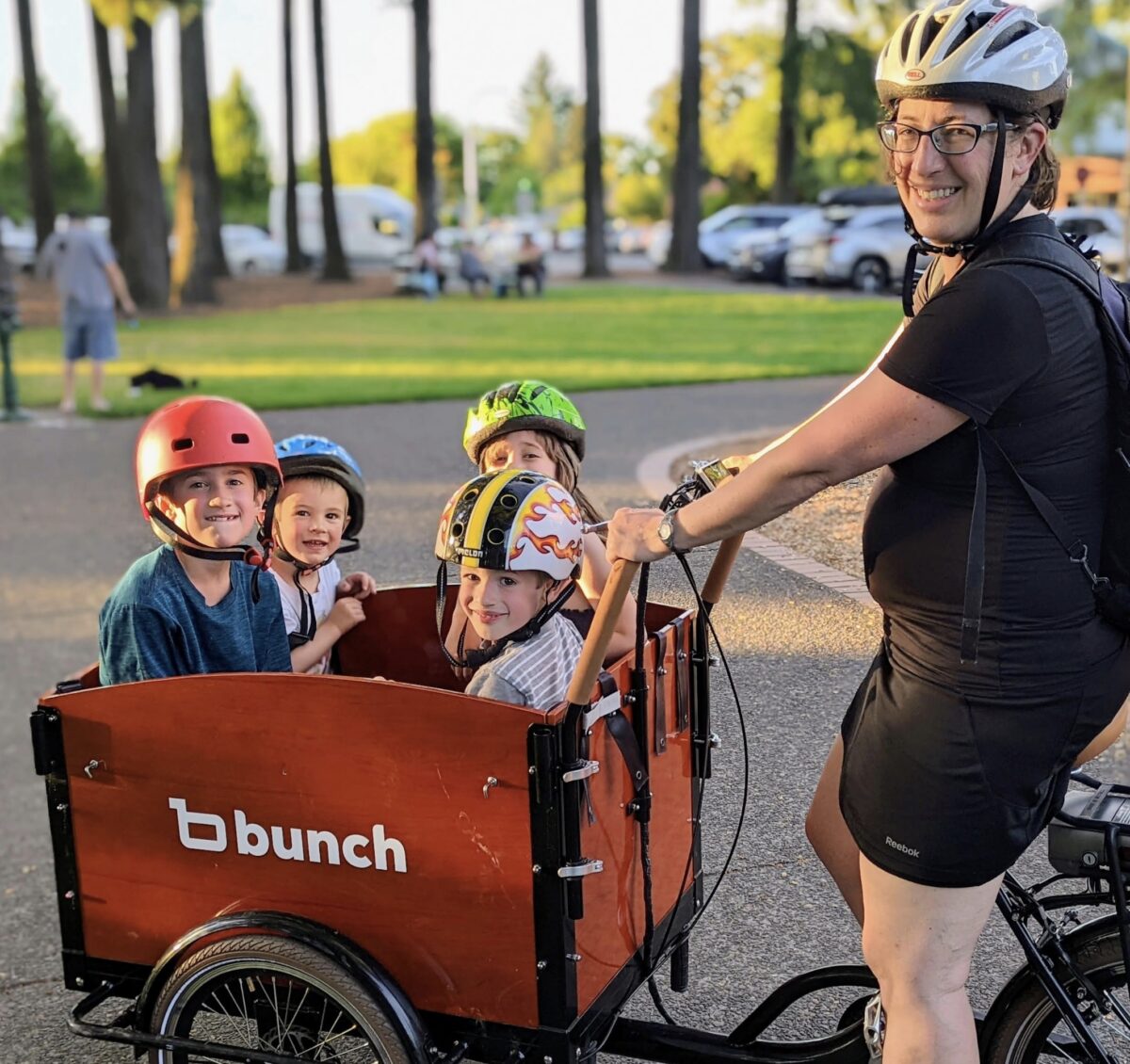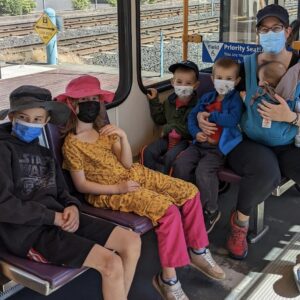Where and how are we most likely to be hit while biking?
It’s not a fun question.
In fact, as I look at it, I think, “Well, that’s the start of an article about how we’re never going to bike with kids again!”
But hear me out: Recently, our family twice avoided being hit by motorists when walking bikes across the street at signalized crosswalks. After these near-misses, I began to question my assumptions about the greatest dangers we face while biking, where those risks are most likely lurking, and how to most safely navigate various biking scenarios. For example, I had been planning to teach my children to take their bikes up on the sidewalk at “scary intersections” and cross the street during the signal as a pedestrian. But is this the safest way to navigate those intersections with bikes? This is the way we were almost hit, twice! Maybe my assumption was wrong. Maybe we’re safer in the bike lane…or even the car lane?
I didn’t know.
I began to wonder about the data around collisions, infrastructure, driver behavior, and biking choices. Could looking at this unsavory bike/ped/car collision data provide me with information that could make me a safer biker? When armed with the data, would I make different biking choices? What would I change, if I knew more?
Learning the causes of crashes: A Conversation with Vivek Jeevan
“Focus on the five.” Vivek Jeevan told me when I reached out with my questions. Jeevan is a cycling safety instructor, advocate, and BikeLoud PDX board member. He has spent a lot of time looking at the behaviors that lead to collisions, and teaching people how to avoid them.
“Focus on the five.” He repeated. “We [need to] focus our resources, which means our education time or education money on the five top causes of crashes or fatalities. That’s something a lot of bike/ped education misses. The people who teach that, they don’t know the data…They’ve heard that, you know, telling pedestrians to have reflective clothing is an important thing. So they equate safety with reflective clothing and then you look at the studies that it’s not the top five causes of crash. It’s a very low cause. So why focus on that?”
I think about how much time I spend tightening helmet straps and tapping helmets back down on little foreheads. Or how I have been meaning to wrap my cargo box in reflective tape. We’ve added yellow rain gear and blinkey lights to improve visibility. It seems I am making the mistake Jeevan is talking about. These little helmets and blinkey lights are not in the top five. They might help us, but we need to focus our family safety talks on avoiding the greatest dangers.
What are the top five?
Unfortunately, this data can be difficult to find, and results vary according to locality, years studied (2020 was an unusual year), and specific definitions (are you looking at bike and ped collisions together or separately? collisions with serious injury, or fatal collisions, or both?)
Jeevan sent me two data sets from Corvallis, where he used to live (above).
These data sets provide some confirmation that our family’s “near miss” experiences are one of the most common ways that pedestrians and cyclists are hit by cars: drivers fail to yield when turning, and fail to yield at a crosswalk.
For Portland, Jeevan sent me a similar chart for car-pedestrian fatal crashes (below). I also highly recommend the 2021 report from Oregon Walks that did a detailed analysis of 48 fatal collisions between 2017 to 2019.
Teaching safety
As Jeevan explains:
“The situation you described of a turning driver not stopping for you in a crosswalk is the top cause of a driver/pedestrian crash. It’s why I stress that situation the most. I tell people to look both ways before driving through crosswalks and driveways. It’s why I organized a table at the PSU Farmers Market for crosswalk safety…where we gave market attendees a three-question quiz focused on the top causes of crashes. The third question had a graphic, and teaches people to look for pedestrians before turning at signalized intersections.”
This is Jeevan’s quiz:
- What is a crosswalk?
- At unmarked crosswalks, when must drivers stop for pedestrians?
- You’re driving and have a green light. Which of these crosswalks has a Walk sign? What if your visibility of those crosswalks is obstructed? (answer: creep forward until you can see. If you can’t see, don’t drive through assuming no pedestrians are coming.)”
Jeevan’s crosswalk lesson applies most specifically to drivers, but it bookmarks the two places I, as a cyclist or pedestrian, need to check each time we cross an intersection. I need to look over my left-shoulder for any right-turning cars that might not see us, and I need to cast a glance across from us at oncoming traffic for any left-turning cars that may not be paying attention. And we need to have a heightened awareness around intersections. A flashing walk signal is not a time to let down our guard. It’s time to look first, before crossing, and keep our awareness high through the entire crosswalk. Unfortunately, based on the data, a walk signal doesn’t mean we’re “safe.”
So, does this knowledge help us?
I think it does. It’s true that our family has focused a lot of safety time and money on gear and lessons of lesser import. In fact, when I think back to the safety lessons I gave my son last year, I didn’t cover this topic at all. We covered the dangers of car doors and cars backing out of driveways….we didn’t discuss the right and left-hook risks. That is, that a right-turning driver coming from behind/beside us would turn into us while we are going straight through the intersection (at the crosswalk or in the bike lane), or that a left-turning driver who is approaching us from the opposite direction might turn into us as we cross straight through the intersection.
These lessons should be at the top of our list, as they are at the top of the list of causes of car-cyclist and car-pedestrian collisions.
About those scary intersections
What about my original question, about how to proceed safely across a certain intersection? Jeevan won’t tell me which choice to make. He wants me to understand the risks, based on the data, so I can make an educated choice.
After considering the dangers of turning motorists who are not always looking for bicycles and pedestrians, I’m considering taking up space like a motorist. I am thinking about “taking the lane” with my cargo bike while having my son ride beside me in the bike lane. This makes us the most visible, and I would be riding in the place of a car, which is the place other motorists are paying attention to.
Of course, every intersection has its local nuances, so there isn’t a one-size-fits-all answer to these questions. But knowing the data can help us better prepare for, watch out for, and avoid the most common risks.










Thanks for reading.
BikePortland has served this community with independent community journalism since 2005. We rely on subscriptions from readers like you to survive. Your financial support is vital in keeping this valuable resource alive and well.
Please subscribe today to strengthen and expand our work.
There’s one factor that I think often gets ignored in discussions of car vs pedestrian/cyclist safety issues. Modern cars and light trucks have much, much wider A-pillars than cars of the past. This is because all new cars incorporate airbags in A-pillars to protect drivers’ and passengers’ heads in the event of a crash. The incorporation of these airbags requires the A-pillars to be much wider than if they weren’t there. And since the A-pillars are wider, they create a blind spot for drivers directly in the direction they may be turning. Even a driver who is careful of pedestrians and cyclists can miss seeing them. It’s happened to me more than once. Fortunately, I spotted the A-pillar hidden pedestrians in time.
There are few people on this planet who know less about cars than I do, so I had to look up “A Pillar” to realize you are talking about the struts between the windshield and the front driver/passenger windows. (B Pillar is between the front and rear passenger windows and C Pillar between the rear passenger and rear windshield.)
I appreciate your pointing out this literal and figurative blind spot, but I disagree with this sentence. Being careful means being aware of your vehicle’s blind spots and moving your head to see what or who is hidden in them.
Nice work Shannon, I totally agree with you. Knowing the threats is very helpful especially when paths cross. Any intersection is where to be most vigilant so I am always focused on finding vehicles larger that me on all approaches, especially from my left and right. I am less worried about what is in front of me or behind generally, but I still check often. About 50-55% of crashes happen at intersections, 20% at driveways, 25-30% between intersections. 2.5x greater chance to be hit from your left than right. Usually more risk of left turning vehicles than right turning vehicles ( I agree with Bryan that A-pillars make a big blind spot.) I like riding as close to the middle of the street as I can if there are no bike lanes; this helps me eliminate rear approach crashes as I can manage the street and move over when I feel it is safe for me to be passed. I almost never move over at intersections, I don’t want to be right hooked when I’m trying to go forward. Ride as much as you can to the left and in front of your younger bike riders. Keep up the great work!
I believe in doing whatever I can to make drivers see me. That includes positioning myself at intersections so that I am as obvious as possible – in the driving lane if necessary. It includes front and light blinking lights to attract attention.
When I have cars around me at an intersection, I look for clues to see what the drivers plan to do. Turn signals are obvious, but also wheels turned.
Whenever possible I try to look at drivers’ faces to see if they actually see me. If I don’t know, then I’m extra cautious.
Fails to yield while turning isn’t that surprising as the number one. What’s surprising is unsafely passes cyclist only being at 1 or 2%. If this data is put together like other data sets I’ve seen I suppose that could be because it’s a secondary cause in other categories.
Either way close passing is certainly what feels like the most dangerous motorist behaviors. Failing to yield while turning or at a crosswalk happens at such low speeds and almost always just leads to me stopping short while they continue that it doesn’t even register with me anymore. I suppose that’s because I have more control in those situations.
Other then taking the lane there’s not much I can do about a driver making the poor decision to pass when there isn’t enough space. If someone is being aggressive for several blocks I’ll pull over but the recent close passes I’ve had were within a few seconds of a driver approaching me.
Great article it’s nice to have these resource to direct people to when discussing driving safety.
I don’t ride on the roads. I live in Anchorage, which has excellent bike trails around town. Of course now that there’s snow on the trails I switch to skis and the bike stays in the garage. I worry that cyclists who pedal will be run off the trails, which ban motorized vehicles, by these motorized eBikes. The cell phone has made streets unsafe for cyclists. The eBike is going to run us off the trails.